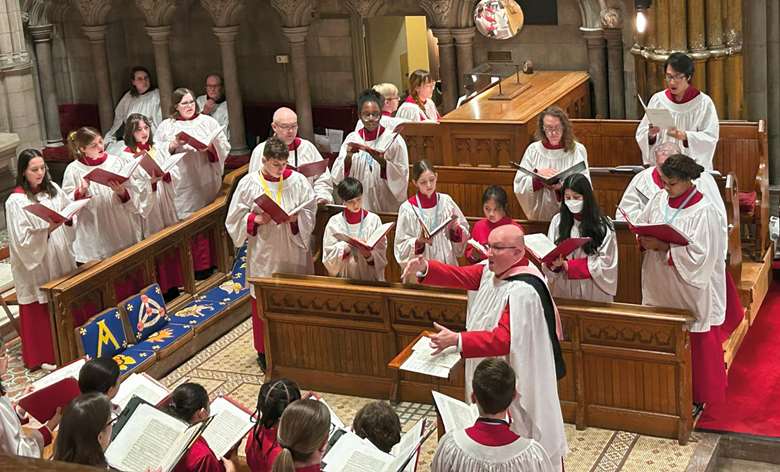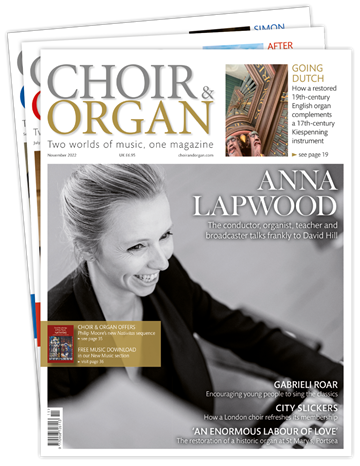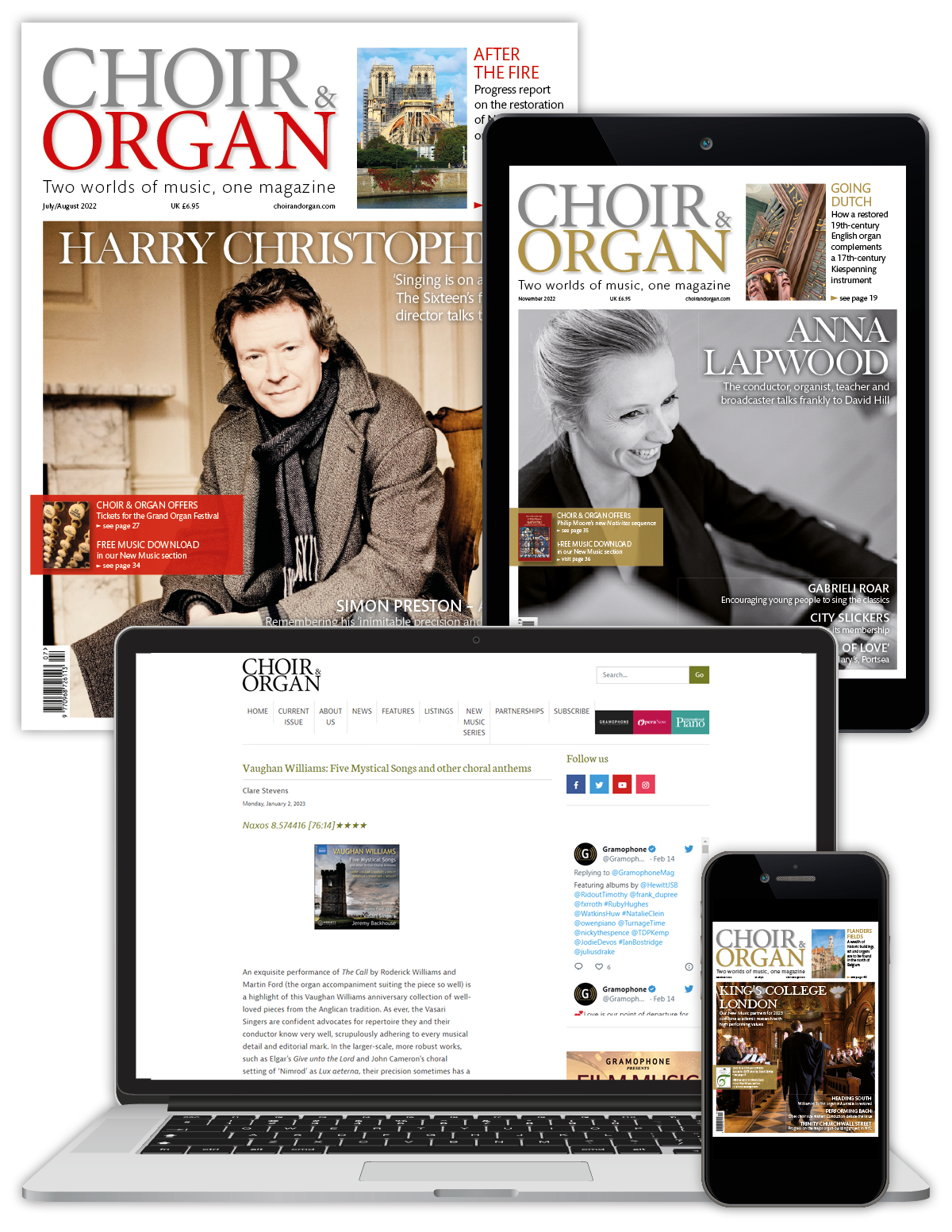Walden Moore's legacy at Trinity-on-the-Green
Jonathan Ambrosino
Friday, May 10, 2024
Jonathan Ambrosino reviews the substantial legacy of Walden Moore, who this year retires after 40 years of service at the church of Trinity-on-the-Green, New Haven, Connecticut

The legacy of Rhea Walden Moore, who in June retires from Trinity-on-the-Green as director of music, will be measured less in headlines and more for its enduring depth. Moore’s work here was both profoundly local – this is first and last a parish church, its singing children a central ministry – and ultimately national, given that Trinity’s organ scholars have gone on to some of the profession’s highest positions, including two to Washington Cathedral and five to Saint Thomas, New York.
Reared in the Virginia hills (a faint twang remains even after decades in the north), Moore embodies tectonic vigour swathed in calm. Upon earning a bachelor’s degree from the University of Kentucky in 1978, Moore came to Yale for graduate work, studying with Robert Baker and Gerre Hancock. Simultaneously he served as Trinity’s organ scholar under Stephen Loher. (Loher was his own force. A pupil and former assistant of Richard Purvis at Grace Cathedral, San Francisco, he arrived at Trinity in 1971 to revive the men and boys choir from near-death, and established the organ scholar system.) After a stint at Saint James, West Hartford, Moore found himself back at New Haven in 1984.
His job began as curatorship, nurturing and building on his predecessors’ work. Under Moore’s leadership, Trinity eventually established a separate men and girls choir, all while building the parish choir and managing ongoing organ restoration. What began as two rehearsals a week grew to five (often with a meal for trebles), considerable parental involvement, and a rotation of choirs singing each Sunday – a workload for none but the indefatigable.
A key culture in Trinity’s musical sourdough comes from Yale University, whose commitment to organ study has provided a stream of graduate-level talent. (In a former generation, Trinity Church in Princeton, New Jersey, enjoyed a similar relationship to undergraduate organ scholars at Westminster Choir College.) To marvel at this tradition is also to rue its rarity on these shores; many churches whose assistant positions once trained students are now occupied by seasoned professionals. Moreover, Trinity’s scholar programme doesn’t exactly align with the Oxbridge mould, since vocal training must proceed without benefit of daily evensong and, from the organ perspective, the traditions of accompaniment are only broadly similar to English practice, instead informed by patterns stretching back to colourful US individualists such as David McKinley Williams, Robert Baker and Gerre Hancock. As much by example as explanation, Moore has been masterful at parsing those differences, particularly demonstrating what is required to keep such programmes aloft in a US downtown church faced with other challenges.
Moore’s style of playing is wedded to the parish’s revered 1935 Aeolian-Skinner op 927, an atypical setup with 53 stops in the west, another 14 in the east. This instrument finds the famous English expatriate G Donald Harrison in transition and early maturity. By mere months, the organ was finished too early to embody certain later American Classic trademarks (no reedless Great or unenclosed Positiv), but far enough along to be voiced on lower wind pressures (31/4" to 5") to a straight scheme with only a single pedal extension. The west section is essentially unaltered; the chancel section was expanded in 1948 and later revised.
Hailed at its unveiling as a Bach organ (we can smile now, even as they were serious), op 927 is instead revealed as the best of late Romantic style, a disciplined intermingling of 19th- and 20th-century English and US ideas. Several Harrison signatures begin to emerge here: broader trebles in the Great flue chorus; narrower Swell reeds with French shallots that, at this early stage, are voiced more for richness than fire; an independent Pedal providing point over ponderousness, but still with weight. Some elements end up as short-term curiosities, such as the elegant family of tapered Choir principals (in line with Schulze or Hill) or that department’s chorus of 8.4.3.2 stopped flutes (in principle akin to Lewis, in practice far smoother and less chirpy). The luxurious range of foundation tone, nothing too far apart in power or colour, would soon be eased out of Aeolian-Skinner instruments, as would the multiplicity of unison trumpets in an organ this size – features that make the instrument superb for choral partnership.
In approaching this instrument, early on Moore chose subtlety over broad gesture, feeling that the west organ’s incredible directness and nearness to the congregation made it more effective when used suggestively rather than emphatically. The Swell reeds, for example, rarely came on as a family, most often one by one in tandem with increases elsewhere. Understanding that too much expression can fatigue, Moore evolved a keen facility in opening the boxes only so far in regular usage. Beyond the organ’s tonal resources, the unaltered console – with its eight generals, seven divisionals per manual and limited couplers – was Moore’s partner in teaching scholars an older registrational approach. Having grown up in an era before multiple memories and solid state, Moore is entirely at home with what are now perceived as limitations, here linking him to more typical English practice. ‘I rarely use generals in hymn playing,’ he remarked recently, ‘and do almost everything by hand.’
The effectiveness of Moore’s playing is hard to pin down; by his own confession, he is not a virtuoso, his recital career has been mostly local, and he has focused on – and gloried in – accompaniment. In common with others of his generation playing in deader rooms, Moore has mastered a kind of super-legato, in which breaths and silences are used with dramatic care, and subtle rhythmic inflection flows from harmonic motion and the specific text.
Beyond the musicality, ex-scholars found in Moore an outsized humanity and generosity – that tectonic force poking through the calm. Erik Suter, who went from Trinity to Washington Cathedral, recalled his first New Haven Christmas. He had not been home in 18 months, and the only airfare he could afford was from Providence, two hours away. When a ride fell through, ‘Walden took it upon himself to drive me all the way to the Providence airport after midnight mass. He must’ve gotten back to New Haven around 4am, then needing to play an 11am Christmas morning Eucharist. That kind of selfless approach to his assistants and everyone else he encounters is so typical of him.’ Jared Johnson, now canon director of music at Grace Cathedral in San Francisco, recalls how Moore aimed to mould the entire chorister, not just the musical one. ‘Every Friday Walden would lead the boys in a group conversation called “Talk Time”. Sometimes he’d pick a topic, but most times he’d ask the boys what was on their minds. Walden always listened to the choristers, and they would speak in open and thoughtful ways about things that were important to them. I’ve never been in a room with more presence of mind, trust or mutual support, than that undercroft, with Walden in the middle of the circle.’
In Holy Week 2018, David von Behren (now assistant organist and choirmaster at Harvard University’s Memorial Church) was stymied, on this of all weeks, to find Moore nowhere in the building. ‘I eventually found him outside, painting white stripes on the church entrance stairs. Walden could have been attending to a hundred other things, but painting stripes on the steps to protect older folks from falling was the most important thing to him in that moment. That simple act of thoughtfulness taught me that he viewed our work as always more than a job.’ Jerrick Cavagnaro, now assistant organist and choirmaster at Trinity Church, Boston, recalls Moore’s endless range of choral problem solvers. ‘Something not tuning because of a vowel? “Get rid of those Connecticut vowels!” and suddenly it’s in tune. Not enough breath to reach a high note? Do it on a lip trill and the passage sounded angelic.’ Similarly with accompaniment, Cavagnaro recalls his first shot at Elgar’s The Spirit of the Lord. ‘After creating what I thought were colourful registrations, I had a coaching with Walden in which he reworked almost every single one of my registrations. With his gentle suggestions and advice, the organ truly sounded like an orchestra.’ Janet Yieh added, ‘The number of former choristers who returned to sing as young adult ATBs was testament to the positive impact Walden’s dedication made on a generation of singers around New Haven and Yale.’ (Moore also taught Yieh how to drive manual transmission.)
In retirement, Moore will continue to teach organ accompaniment at Yale, alongside Martin Jean and James O’Donnell; this autumn he serves as interim at a Connecticut church, and will likely do so in the years to come. Trinity has appointed an interim director of music for 2024/25, after which a permanent appointment will begin. Associate director of music Sarah Johnson and an organ scholar will provide continuity during the 2024/25 year. Moore leaves behind the proverbial big shoes: musician as churchman and mentor par excellence, a four-decade sermon in service.
Jonathan Ambrosino is an organ technician based in Boston, Massachusetts, and a consultant to organ projects across the USA
He has written for C&O since 1998
This article originally appeared in the Summer 2024 issue of Choir & Organ. Never miss an issue – subscribe today






